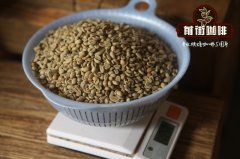The coffee history of Brazil? Brazilian bourbon coffee flavor? What is the flavor of Brazilian Santos coffee?

Professional coffee knowledge exchange More coffee bean information Please pay attention to coffee workshop (Weixin Official Accounts cafe_style)
Brazil's coffee history? Brazilian bourbon? What is the flavor of Brazilian Santos coffee?
Brazil has been figuratively compared to the "giants" and "kings" of the coffee world. There are about 3.97 billion coffee trees, and small farmers now grow 75 percent of the country's coffee. Brazil has twice or even five times as many coffee producers as Colombia, which is the world's third-largest coffee producer. Unlike in the past, Brazil's economy is now less dependent on coffee, which accounts for only 8 -10% of GDP. Before World War II, Brazil accounted for 50% or more of the world's coffee production, and now it is close to 30%, but the country's influence on coffee worldwide, especially on coffee prices, is significant. For example, two frosts in 1975 and 1994 caused global coffee prices to skyrocket. Coffee production has gradually become a science since coffee trees were introduced from Guyane française in 1720. Before 1990, the Brazilian government strictly controlled the coffee industry, with both severe intervention and price protection measures, and the state has always implemented a minimum price protection policy for farmers, resulting in coffee overproduction. At one point before World War II, there were 78 million bags left in stock, which had to be burned or thrown into water for destruction. Since 1990, when the free market opened up, the former Brazilian Coffee Authority has been replaced by the National Economic Institute, a non-investment administrative body of the State, which pursues a non-interventionist policy and allows producers to negotiate directly with exporters. The activities of exporters are regulated by government legislation and legal exporters are registered by the relevant authorities. Because of the wide variety of Brazilian coffee, the word "Brazilian coffee" cannot be used to cover it.
Just like any other coffee. Brazilian coffee is called "Brazils" to distinguish it from "Milds" coffee. The vast majority of Brazilian coffee is unwashed and dried, and they are classified according to the state of origin and port of shipment. Brazil has 21 states, 17 of which produce coffee, but four of them produce the most, accounting for 98% of the country's total production. They are: Paraná, Sao Paulo, Milas Gerais and Espírito Santo. Paraná in the south produces the most, accounting for 50% of the total. Although coffee is diverse, Brazilian coffee is suitable for the taste of the masses. For example: coffee produced in northern coastal areas has a typical iodine taste, reminiscent of the sea after drinking. This coffee is exported to North America, the Middle East and Eastern Europe. Another coffee that is interesting and worth pursuing is rinsed Bahia coffee. This coffee is not easy to find because Brazil is the world's largest coffee consumer after the United States, and many of the best coffees can only be found in its domestic market. In Brazil, the second largest producer is Robusta coffee. This coffee is sold in supermarkets. Robusta coffee, sold under the name Conilon, accounts for 15 percent of total production. Old Bourbon coffee is grown on some estates in the Cerrado district of the state of Milas Gerais in southeastern Brazil. These estates, such as Capin Blanco Estates and Vista. Alegre Manor, which grows Bourbon old-variety coffee, is also on sale in the city. Although they come from the same region, these coffees have their own characteristics. Capim Blanco is softer than Vista Allegre, which is strong and dark, and relatively low in acidity, but like all Brazilian coffees, they are best drunk fresh because the older they are, the stronger the acidity. These coffee growers have organized themselves into the Brazilian Specialty Coffee Association. Coffee overall impression There are many kinds of flavors, many flavors, but most of them are low coffee, smooth taste recommended low to deep roasting, suitable for a variety of uses Grade good. Brazil is the world's largest coffee producer. Yield first, quality stable. The Arabica species. Dry treatment is adopted. Aroma and taste moderate. There's almost no sourness. It represents neutral coffee. It can be said that it is the most suitable variety for mixed coffee. Saint-Toth, especially Bourbon bourbon Saint-Toth (named after the French colonial island Bourbon bourbon) Bourbon, now known as Réunion (where the coffee saplings that brought Para were planted), is known for its special aroma, flawless, neutral taste, and can be cooked directly by itself. It is also a good partner for Italian beans. The real Bourbon Santos are the beans from the first few seasons of the mocha coffee tree. After three or four years, the beans changed character, and by the sixth year, they became Flat Bean Santos. Red saint toasts taste sweet, bourbon saint toasts taste bitter, fresh saint toasts taste sour, aging will reduce the sourness Recently, the "Tolma Cup" has also been highly rated.
Important Notice :
前街咖啡 FrontStreet Coffee has moved to new addredd:
FrontStreet Coffee Address: 315,Donghua East Road,GuangZhou
Tel:020 38364473
- Prev

What kind of utensils do you use to brew Vietnamese coffee? How to make Vietnamese coffee? The skills of making Vietnamese coffee and
Professional coffee knowledge exchange more coffee bean information please follow the coffee workshop (Wechat official account cafe_style) what utensils are used to brew Vietnamese coffee? How to make Vietnamese coffee? Tips and tricks for brewing Vietnamese coffee? Coffee users all know that coffee is actually a necessity of life. If you don't drink it for a day, you will be in a trance. In Vietnam, the number of coffee shops is numerous, and Vietnamese like it.
- Next

Flavor characteristics of Brazilian Santos Coffee introduction of Brazilian Santos bourbon varieties of coffee beans
Professional coffee knowledge exchange more coffee bean information please follow the coffee workshop (Wechat official account cafe_style) what are the flavor and taste characteristics of Brazilian Santos coffee? Is the Brazilian Santos a bourbon? What are the flavors and characteristics of bourbon? Santos-17 Brazil Santos SS Fine Cup SC 18 talking about Brazil Santos, except for the football team
Related
- Detailed explanation of Jadeite planting Land in Panamanian Jadeite Manor introduction to the grading system of Jadeite competitive bidding, Red bid, Green bid and Rose Summer
- Story of Coffee planting in Brenka region of Costa Rica Stonehenge Manor anaerobic heavy honey treatment of flavor mouth
- What's on the barrel of Blue Mountain Coffee beans?
- Can American coffee also pull flowers? How to use hot American style to pull out a good-looking pattern?
- Can you make a cold extract with coffee beans? What is the right proportion for cold-extracted coffee formula?
- Indonesian PWN Gold Mandrine Coffee Origin Features Flavor How to Chong? Mandolin coffee is American.
- A brief introduction to the flavor characteristics of Brazilian yellow bourbon coffee beans
- What is the effect of different water quality on the flavor of cold-extracted coffee? What kind of water is best for brewing coffee?
- Why do you think of Rose Summer whenever you mention Panamanian coffee?
- Introduction to the characteristics of authentic blue mountain coffee bean producing areas? What is the CIB Coffee Authority in Jamaica?

